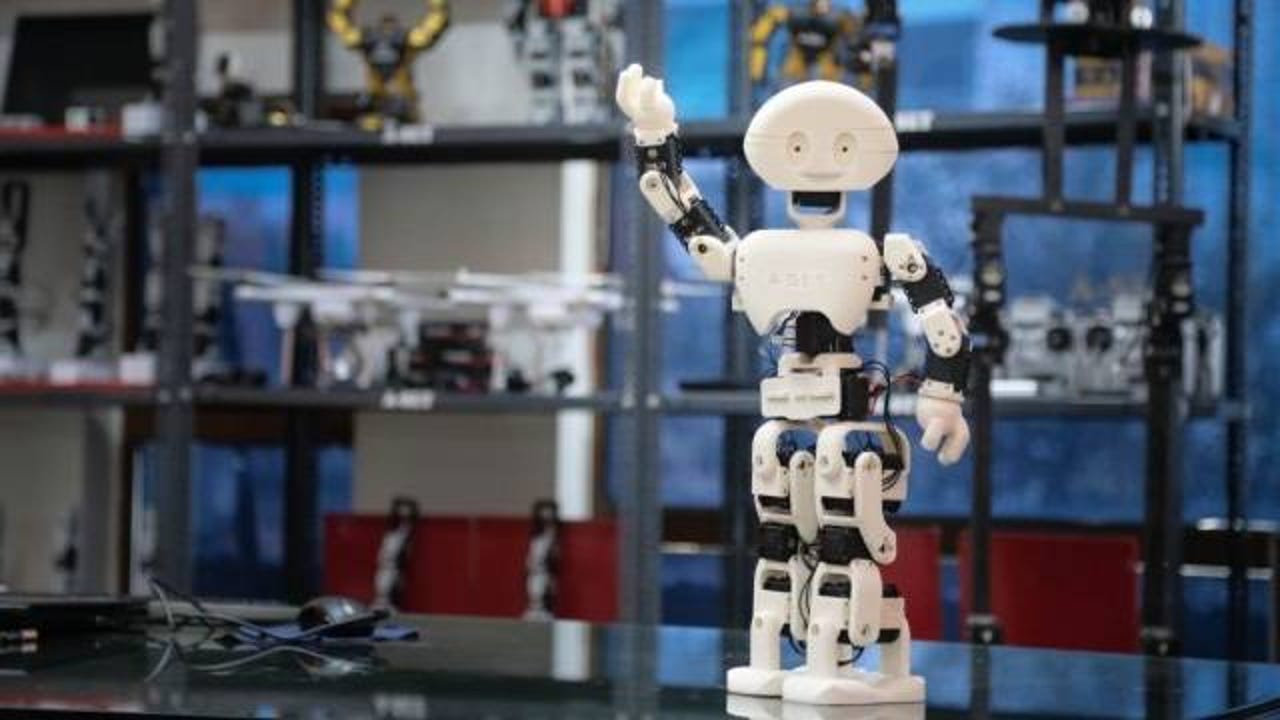India's latest robot sensation

Ladies and gentlemen, there's a new robot in town. Its name is Manav, it's made in India, it weighs under 5 pounds, and it can walk, talk, and dance upon hearing simple voice commands.
The little fella was built at the A-SET Training and Research Institute in New Delhi (an academy dedicated to training students in the assembly and repair of electronics and computer devices and instruments), and made its debut at the Indian Institute of Technology (IIT) Bombay campus a few weeks ago at a tech symposium that featured attending luminaries such as Bjarne Stroustrup, father of C++, as well as Dr Vint Cerf, one of the founders of the internet. Manav is powered by 21 servos, with two cameras for eyes and microphones for ears that can pick up and respond to the direction of sound.
While these memorable machines and forms of created intelligence have all been rendered by pen and prose, scarily, none of the advances in robotics today seem to be that far removed from many of the seemingly improbable visions of intelligent machines conjured up by these movies. In fact, they can be simply terrifying, and, more importantly, real. The SandFlea, for instance, carries an on-board camera and can jump 30 feet. The Cheetah can apparently reach speeds of up to 28mph, and easily chase down super-sprinter and Olympic champion Usain Bolt. The LS3 can haul 400lbs of equipment, and can track a fellow LS3. In other words, there's really no getting away from them, not even if you offer them lubricant or more memory.
Then there's the invincible "Atlas", something that would do Ayn Rand proud in terms of sheer ability. Atlas has been redesigned by Boston Dynamics for the US Department of Defense's Defense Advanced Research Projects Agency (DARPA), so it can now shrug demurely while it drives a car, smashes through walls, and traverses buildings while signalling its arrival as a strong contender for the global DARPA Robotics Challenge. This gauntlet revolves around the task of designing and testing a robot that can save human lives after a natural disaster, such as an earthquake or a tsunami, for the not-so-inconsequential prize of $2 million (with second and third place netting $1 million and $500,000, respectively). Approximately 20 teams will be competing in the challenge.
Alright, so the diminutive Indian Manav may not exactly set DARPA on fire. But a Manav-like robot has other advantages. It functions on an open-source code, and for the moment has been designed to be used as a learning platform that ultimately may just turn out to be a little more useful in the long run than a DARPA participant.
But there's a more realistic reason as to why Manav could insinuate itself into your life very soon: Cost. The robot, which inventor Diwakar Vaish took two months to design, fabricate, and put together, was all made from parts manufactured and then 3D printed in India, for the rock-bottom price of Rs.1.5-2 lakh ($3,300). In fact, most prognosticators of the near future think that robots will be a very integral part of your life sooner rather than later, as fast-food workers, drivers, cashiers, and even priests, for God's sake. (A robot priest apparently married a Japanese couple a few years ago.) Manav could soon be doing many of these things, and for dirt-cheap prices in the long run.
As it is, doctors are increasingly resorting to robotic technology for complex things like neurosurgery, even in places like India. These robots are described as a "GPS to the brain", and are depended upon for their "guidance, precision, and accuracy". In the burgeoning field of e-commerce, robots are proving to be critical in moving items in warehouses with speed and efficiency, where quick turnaround of packages and a reduction of human error is crucial to the bottom line and a company's ERP. Some, like the recently introduced Roomba 880, will do more mundane but necessary tasks such as thoroughly vacuuming your house while you go through a six pack and watch the game of the week.So it may be ultimately heart warming that countries like Japan and Korea, which don't just have the highest number of robots commissioned to do the work of humans in factories, but also the highest ratio of humans to robots in general, have actually brought people back to take over work given to these unfeeling machines. Apparently, after decades of experiencing machines doing work quickly and at cut-rate prices, no less an icon of quality control than Toyota decided that alas, humans are in fact better suited to a lot of the functionalities on the assembly line, such as crankshaft production. Apparently, when it came to craftsmanship, process design, and even consistence of quality, machines were a poor second to humans.
While that's great news for you and me, what does this mean for Manav, the pint-sized Indian robot? Well, keeping it as a domestic slave (like we do to pretty much all our help in India) is always a viable option. And exporting him to countries that crave domestic help -- say, a house cleaner or dog-walker extraordinaire -- but can seldom afford it could perhaps translate into a solid dollar-earning export. Tack on an ability to cook up a chicken tikka masala, and you may just have the most successful export in Indian history.
And if that doesn't work out so well, it could at least be immortalised by some contemporary cinematic wunderkind in a work that hints at all of its wonderful possibilities; wouldn't it be wonderful if someone who is perhaps even a spiritual heir to the throne of Cameron and Scott (dare we say George Romero?) finds it necessary to reimagine Manav as Chuckie the doll in yet another homage to our ongoing love affair with machines?